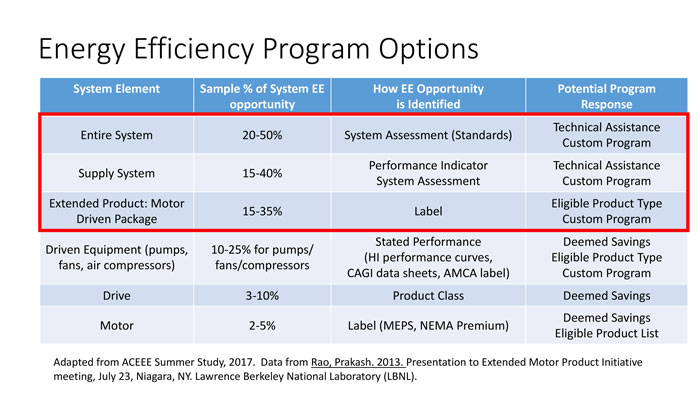One of the biggest issues that pump system owners, operators and users will want to begin tracking in 2018 is utility incentive programs. While pump manufacturers have been focused on energy efficiency and the related Department of Energy (DOE) regulations the past few years, utilities have been steadily working toward expanding their efficiency programs into the industrial and commercial space.
Relatively straightforward regulations and incentive programs have been in place for motors and drives. These component-based programs have contributed significantly to energy-efficiency efforts, but they represent a small percentage of the potential energy savings. The potential for energy savings from pump systems alone is estimated to be 234 million megawatt hours (Mwh) of primary energy.
Utilities drive increased energy efficiency across sectors and product categories through financial and technical support, spending close to $9 billion annually. The Consortium for Energy Efficiency measures the size of the energy efficiency industry annually by gathering data from more than 300 program administrators in the United States and Canada. Package and system savings are harder to quantify and measure than component savings, but the impact is greater and HI is working to support these opportunities.
In the case of working toward deemed incentives (the preferred route for utilities because they are easier to manage and results can be measured), the Hydraulic Institute Energy Rating Label plays a central role. The label is adaptable to system requirements, constant or variable speed, and covers the pump types within the scope of the DOE regulations. Utilities, end-users and specifiers can consult an on-line database of bare pumps or pump packages with the HI Energy Rating Label. Manufacturers are testing and listing now to ensure the greatest selection possible in the database as utility programs build throughout 2018.
 Table 1. Energy efficiency program options (Courtesy of the author)
Table 1. Energy efficiency program options (Courtesy of the author)System Assessment
Operators who take the time to analyze their systems for savings are often surprised at the opportunities they find. Many of the end-users the Hydraulic Institute works with in training programs identify savings in the 20 to 50 percent range after they perform a formal pump system assessment.
The Hydraulic Institute created the Pump System Assessment Professional (PSAP) certification to qualify individuals who perform these complex audits. PSAPs play a valuable role where measurement and validation is required. Assurance that these tasks are done by a certified professional will be increasingly important as utilities seek to verify that the savings they anticipate from equipment upgrades become a reality. Energy efficiency consulting firms that have spent the last several years conducting lighting and other energy assessments will likely pick a few certified PSAPs to expand their business portfolio.
In most facilities, those who operate and maintain the pumping systems have probably never seen their utility bill and have no idea how much their organization pays for energy. But imagine if they did. Armed with that knowledge, a thorough understanding of their system, a list of savings opportunities and pay-back periods and utilities stand ready to chip in for the upgrades.



 See more of our State of the Industry 2018 coverage.
See more of our State of the Industry 2018 coverage.